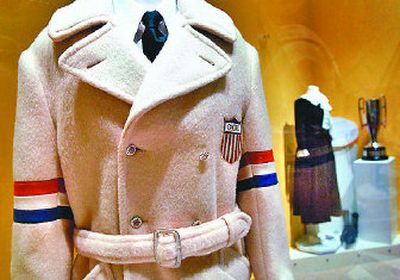HISTORY ON ICE

With all the excitement over the U.S. Figure Skating Championships, now might be the perfect time to drop by the “Figure Skating: American Champions” exhibit under way at the Northwest Museum of Arts and Culture.
Neatly tucked into the small gallery at the far end of the museum’s exhibition area is a unique collection of objects rarely seen outside of the World Figure Skating Museum and Hall of Fame in Colorado Springs, Colo.
“When we were first negotiating for the exhibit,” said Larry Schoonover, the museum’s former director of exhibits and programs, “we put together a wish list of items we thought folks would enjoy seeing.”
While not everything on the list was available for loan, Schoonover said, “we ended up with a number of pretty interesting pieces including Dick Button’s 1948 Olympic team jacket and gold medal.”
Button, then an 18-year-old skater from New Jersey, brought home the first gold medal in skating for the United States when he won the Men’s Figure Skating event in St. Moritz, Switzerland.
The 1948 games were especially meaningful because they were the first Olympic Winter Games to be held since 1936 due to World War II.
It is said that Button revolutionized the sport when he successfully performed the first-ever double axel in Olympic completion and received the first 6.0 in free skating.
At that time gold medals were presented in small decorative boxes and not attached to ribbons to be worn around the neck.
“I believe the medal on view in Spokane is the one he had made into a belt buckle and presented to his father,” said Beth Davis, curator at the World Figure Skating Museum and Hall of Fame.
“If you look closely,” she said, “you will be able to see a couple of loops welded on the back.”
Button dominated the amateur figure skating for seven years in the late ‘40s and early ‘50s. He was the only man to win top honors in the Olympic, World, European, North American and U.S. national competitions, and in 1948 he held all those titles simultaneously.
Four years later, Button went on to again win the gold in Oslo, Norway, where he was the first skater to execute a triple loop jump. He is also known for inventing the flying camel spin.
Additional highlights in the figure skating display include performance costumes, photographs and ephemera from several American champions, including Brian Boitano, Peggy Fleming, Tara Lipinski, Janet Lynn, and ice dancing team Elizabeth Punsalan and Jerod Swallow.
The other gold medal on exhibit was won in 1998 by Tara Lipinski, the youngest ladies figure skating Olympic gold medalist. Lipinski was only 15 years and 8 months – two months younger than Sonja Henie of Norway at the 1928 Olympics.
Also on view is an elegant chartreuse costume from one of Peggy Fleming’s television specials following her 1968 Olympic performance in Grenoble, France.
(Both Button and Fleming are expected to be in Spokane as part of the ABC television team covering the competition.)
After viewing the neon-colored and form-fitting skating costumes of contemporary champions, it is fun to image how Theresa Weld Blanchard performed in her ankle-length corduroy dress with matching hat for the 1914 U.S. National Championships.
Back in the corner of the exhibition space is a replica of the outfit worn by the first U.S. Figure Skating Champion.
On the 50th anniversary of her 1914 U.S. Championship, Blanchard said: “In those days … ladies wore long dresses and hats – their shoes were black, of course. My dress was black corduroy, buttoned down the front, with white pique collar and lace jabot, also lace frills at the cuffs. It came below the tops of my skating boots. With this charming outfit I wore a black felt tricorne hat with white wings on each side of the front point.”
“Blanchard is a very important person to the sport,” said Davis. Her 10 consecutive U.S. Ladies Singles titles are second only to those of Michelle Kwan, who now holds the record with 11.
Blanchard also made history when she was the first U.S. skater to win an Olympic medal.
In 1920, the 27-year-old captured a bronze in Ladies Figure Skating at Antwerp, Belgium.
She also performed in Pairs with partner Nathaniel Niles. The two amassed nine gold and two silver medals in national competition. They placed fourth in the 1920 Olympics.
“She was an incredible lady,” said Davis.